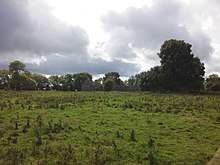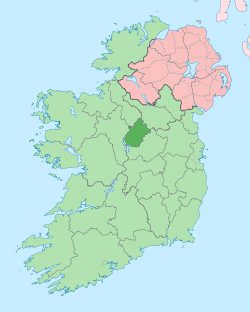Inchcleraun
Inchcleraun (Irish: Inis Cloithrinn), also called Quaker Island, is an island situated in Lough Ree on the River Shannon, in central Ireland.[1][2][3][4][5]
| Native name: Inis Cloithrinn Nickname: Quaker Island | |
|---|---|
 Inchcleraun | |
| Geography | |
| Location | River Shannon |
| Coordinates | 53.584°N 8.011°W |
| Area | 0.577 km2 (0.223 sq mi) |
| Administration | |
| Province | Leinster |
| County | Longford |
| Demographics | |
| Population | 0 |
The island is home to the ruins of St. Diarmaid’s Monastery, a monastery founded by Diarmaid the Just in AD 560. These buildings constitute a National Monument.
The island
Inchcleraun is an island of 57.7 ha (143 acres) located in the centre of Lough Ree, with Knockcroghery, County Roscommon to its west and Newtowncashel, County Longford to its east..

History
The island takes its name from Irish for "Clothru's Island". In Irish legend, Clothru was a daughter of Eochu Feidlech, then High King of Ireland. She became the Queen of Connacht after her father’s death, and once owned the island. Her sister, Medb, retired to Inchcleraun after Medb's husband Ailill mac Máta killed her lover Fergus mac Róich. One point is called Grianan Meva ("Medb's sunny place"), and nearby is Innadmarfa Meva (Ionad Marbhtha Meidhbhe, "Place of Medb's death"), where she was killed by a stone thrown from Elfeet Castle, on the Longford side of the lake. In other versions of the legend, it is a lump of cheese fired from a slingshot by a nephew of Clothru.[6]
The name "Quaker Island" is more recent, and owes to the island being owned at one time by a Quaker. The island is today owned by the Irish state.
Annalistic references
- 719 St Sionnach of Inchcleraun died on 20 April.
- 769 Curoi, the son of Alniadh, Abbot and Sage of Inchcleraun, and of Caill Fochladha (Lough Derravaragh) in Meath died.
- 780 Eochaidh, the son of Focartach, Abbot of Fochladha and of Inchcleraun, died.
- 1010 The men of Munster plundered Inchcleraun and Inis Bo-finne
- 1050 Inchcleraun was plundered
- 1087 The fleet of the men of Munster, with Muirchertach Ua Briain, sailed on the Shannon to Lough Ree and plundered the islands of the lake (inc. Inchcleraun)
- 1136 Áed Ua Finn (Hugh O'Flynn), the Bishop of Bréifne, died in Inchcleraun
- 1141 Giolla na Naomh Mac Fearghail, chief of the people of Annaly (Angaile), the most prosperous man in Ireland, died at a great age and was buried at Inchcleraun.
- 1150 Morogh, the son of the above, the tower of splendour and nobility in East Connacht died in Inchcleraun.
- 1160 Gilla na Naomh Ó Duinn, ollam of Inchcleraun, teacher of history and poetry sent his spirit to the Supreme Father amidst a choir of angels on the 17th day of December in the year of his 58th birthday.
- 1167 Cinaeth Ua Cethearnaigh, Priest of Inchcleraun died.
- 1168 Dubhcobhlach, the daughter of O'Quinn, wife of Mac Corgamna, died and was interred in Inchcleraun
- 1170 Diarmaid Ó Briain, Coarb of Comman, was chief senior of the east of Connaught, died in Inchcleraun in the 95th year of his age.
- 1174 Rory O'Carroll, Lord of Éile, was slain in the middle of Inchcleraun
- 1189 It was at Inchcleraun on Lough Ree that the hostages of O'Connor Maon-Moy were kept at the time.
- 1193 Inchcleraun was plundered by the sons of Costelloe and by the sons of O'Connor Maon-Moy
- 1232 Tiapraide O' Breen, Coarb of Saint Coman, an ecclesiastic learned in History and Law, died on his pilgrimage on the island of Inchcleraun
- 1244 Donnchad mac Fíngein Ó Conchobhair, who was the grandson of Hugh, son of Torlogh O'Connor, Bishop of Elphin, died 23 April on Inchcleraun,and was interred in the monastery of Boyle.
Buildings
Between 800 and 1300 the island and its churches were repeatedly plundered and burned by invaders, so the buildings are in ruins today. Six of the island's churches are surrounded by an enclosure in the southeast corner of the island.
Templedermot
A monastery founded by Saint Diarmaid the Just in 540 AD is the most prominent ruin. Diarmaid was a teacher of Ciarán of Clonmacnoise.
Templemore
This monastery is by far the most important ruin on the island. The church consists of a single nave 14.5 m (48 ft) long and 6.5 m (21 ft) wide. The walls are about 4 m (13 ft) high. There are two graceful lancet windows at the east end which are long, narrow and well recessed.
The windows on the south side have the appearance of later additions and are unsymmetrical. All traces of doors have vanished, but the opes, which have been arched and protected by the Board of Works, seem to indicate the position of a west door and an entrance on the north side to the cloister. An upper chamber exists and when perfect, covered the Chapter-house sacristy, and the east cloister, the internal walls of the lower apartments forming intermediate supports for the flooring. The interior walls of the church were once plastered.
John O'Donovan referred to this building as two churches: the monastic apartments as one and the vaulted sacristy as a penitential prison, labelling it "Deartheach".
Templemurry
The largest church. According to local lore, any woman who enters Templemurray will die within a year.
Clogas
One of the churches, crowning the highest point of the island. has a square bell tower (Irish: clogas), which is attached to the main building, which is . Most churches of this era had round towers, separate from the main building. It is located on the northern part of the island and is visible from the shoreline. On the plan the church is rectangular, being 10.6 m (35 ft) by 5.1 m (17 ft).
References
- Heraghty, Michael (15 October 2004). "Inchcleraun Island / Quaker Island - Longford -".
- "Islands".
- "Inchcleraun (quaker island), County Longford".
- "Lough Ree".
- "Inchclearaun Island - Newtowncashel - Co. Longford".
- Library, Longford. "Longford Library".
